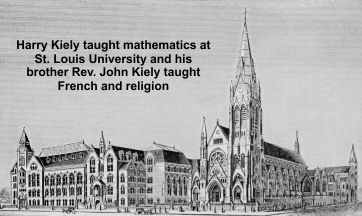|
Canadian Henry "Harry" M. Kiely†
(b.1877) was a lay math professor at St. Louis University and a skilled athlete.
He played basketball, football, hockey,
rugby, lacrosse, and boxed. In 1903 he played cover
point defense for the St. Louis Worlds Fair Hockey
team for coach Robert "Pop" Gillespie,
as well as center halfback on the Spalding
association football team in St. Louis. In 1917, writing about the role of Harry's death
on the breakup of the St. Louis hockey team,
St. Louis Post-Dispatch described Kiely as "the greatest all-round athlete that St.
Louis ever turned out."
In December '03 the St. Louis team was badly trounced by
Portage Lake of Houghton in Michigan's Upper Peninsula, said to be one of
the best teams in the
International Professional Hockey League. Coach, Gillespy, a native Canadian, had
proudly challenged the Portage Lake team. Twenty-four years later Pops said that at first
in the game it was as if his boys were frozen fast in the ice, so fast were the Canadian players.
A humbled coach described the game:
"We tried to rough it but the Canadians beat us at that. The game was played in a high-boarded
enclosure with no place to get out. Every one in a while a Portage Lake man would give one of us the
[undecipherable] and on these occasions our boys were plastered against the boards like mud pies.
They stuck for a few seconds and then fell off. The wonder is not that we lost 3 to 2 but that we ever
scored a goal. "
Harry left the ice with a broken nose; his team with dampened spirits. Though Portage Lake liked
the World's Fair team and offered them a top spot in the next season schedule, there wasn't a rink for them in St.
Louis and the team's future was doubtful.
The team left the shores of Lake Superior and headed south through Wisconsin. At Chicago they parted
ways, the team going on to St. Louis and Harry remaining to spend time with family. Five of his
siblings lived in Chicago. (He also had two siblings in
Duluth, one in Ontario and his brother John taught
French and religion at St. Louis University.)
|
 |

The Iroquois
Reportedly Harry's body was found covering the body of a young woman. Whether it was his theater
companion or a stranger is not known. The story of his body being identified
at the theater is improbable.
His body was taken to Buffums Funeral home where
it was identified by his brother, Joseph Kiely.
The body was then transported to St. Louis on
the Grand Trunk Railway.
Funeral
Services were held at the Holy Family Church and burial was at Mount Olivet Cemetery in St. Louis.
In the years after the fire
Soccer players in a game played in St. Louis four days after the fire on January 3, 1903 wore mourning bands of
black crepe on their arms to honor Harry.
Harry's team, the Spauldings, his center halfback position filled by
Tim McCarthy, defeated the Sportsmen 2 to 0.
|
|
Discrepancies and addendum
In the odd co-incidents category is a relationship that went unreportedin 1903. Harry
Kiely's sister, Jessie Kiely Bartlett, was married to Leroy Bartlett — brother of
Jessie Bartlett Davis, wife of Iroquois Theater manager
Will J. Davis. Yes, there are two women named Jessie in that tangle. I found surprisingly
little published about the circumstances of Harry's Iroquois Theater excursion. Perhaps the
families circled to protect their privacy. To further complicate, the relationship may have
been strained. In December 1893 there had been a financial dispute between Leroy Bartlett
and his sister that resulted in Leroy filing suit against Jessie Bartlett Davis over $200 ($6,600 today).
Before it was over, Will J. Davis had been arrested for assault and battery and resisting police.
When a constable served the debt writ on Jessie Bartlett Davis, who was with her husband Will J. Davis
in his office at the
Columbia Theater, Will and one of his employees, a theater doorman named Ham, attacked the constable. The suit
against Davis was dismissed because the constable didn't appear in court. I have little doubt
that constable McInerny's wallet was a little fuller.
* Margaret may have been Thomas's second wife. There were so many men in St. Louis named
Thomas Kiely 1880-1903 that I wouldn't stake so much as a Ritz cracker on it but I think he may have
been first been married to Anastasia Hayes, with whom he had four sons.
† In some early newspaper victim lists Harry was identified as Harvey. A few newspapers
speculated, incorrectly, that some of Harry's team mates were probably also Iroquois victims. One
newspaper story about sports said that he sometimes went by Mathew but I haven't looked for him by that name.
|
